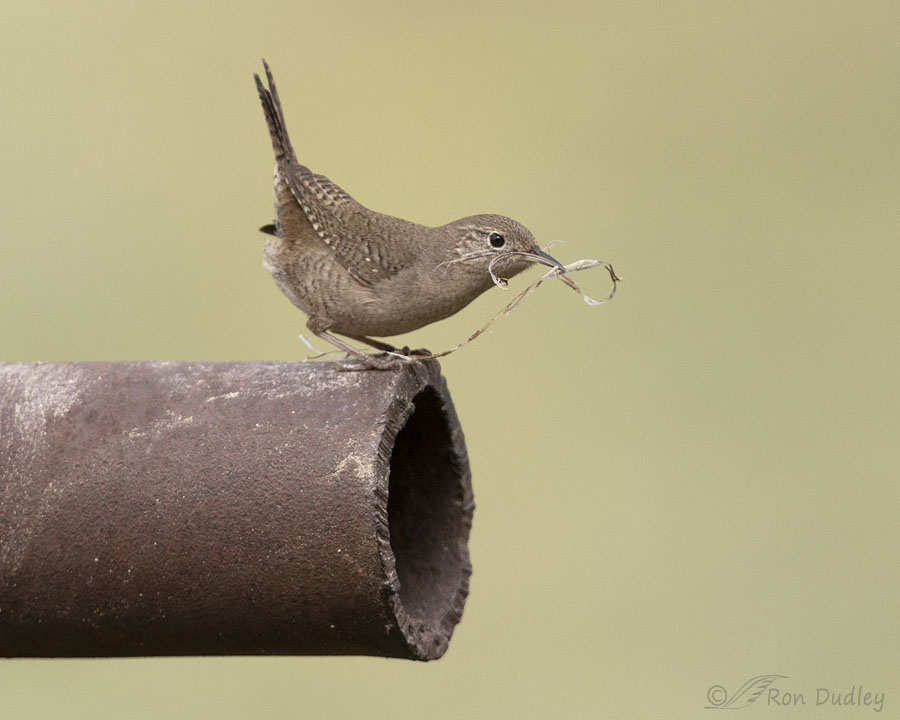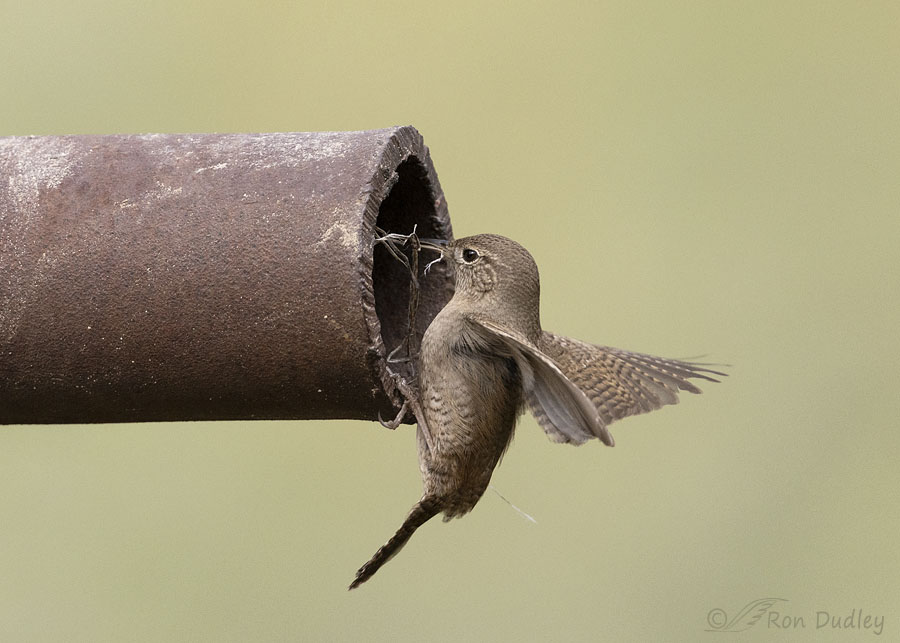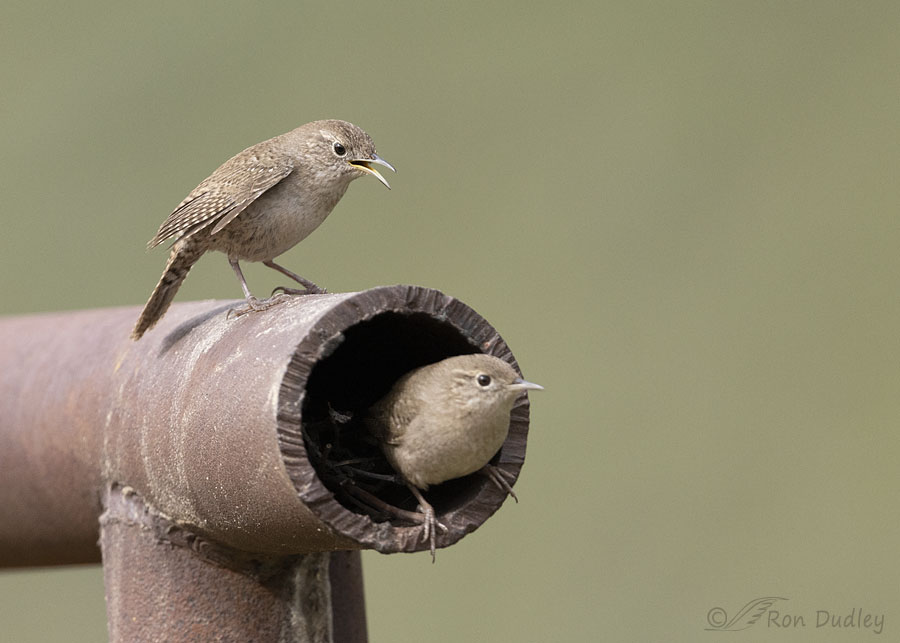Photography rules – meant to be broken?

1/6400, f/6.3, ISO 1600, Canon R5, Canon EF500mm f/4L IS II USM + 1.4 tc, not baited, set up or called in
Several weeks ago I spent a few minutes with a pair of House Wrens in the mountains. Their nest was in this rusty old pipe and here the female (females do most of the nest building) was about to enter the pipe with yet another strand of dried grass for its construction.
Getting from the top of the pipe to the actual entrance requires some pretty impressive acrobatics so I was trying to capture her in some interesting postures as she fell and twisted in the air in order to grab the bottom edge of the pipe with her feet. But mostly I failed.

1/6400, f/6.3, ISO 1600, Canon R5, Canon EF500mm f/4L IS II USM + 1.4 tc, not baited, set up or called in
The maneuver was just too fast – the best I did was to catch her just as her feet grabbed the bottom of the pipe while her wings were still out. This might be one of those times when it would pay for me to switch over to using the electronic shutter of the R5, which has a much faster burst rate of 20 frames/second.
Next time maybe I’ll actually think of doing it.

1/5000, f/6.3, ISO 2000, Canon R5, Canon EF500mm f/4L IS II USM + 1.4 tc, not baited, set up or called in
I have mixed feelings about this last shot. I was happy to capture both wrens in the same photo, especially with the male “talking” to his mate (giving directions?), but I didn’t have enough depth of field to get them both sharp – the female inside the pipe is soft.
Amongst bird photographers there’s a general rule of thumb saying that if you have two or more birds in the frame and you can’t get them all sharp, the best option is to get the front bird sharp. I tried, but this was one of those times when the animal/eye detection feature of the R5 grabbed onto the eye of the bird in the back. I didn’t have time to manually move my active focus point so my only choice was to take the shot as it was or miss it altogether.
Oh well, I still like the photo and besides, there’s another rule of thumb that says “rules are meant to be broken”. In this photo, given the more interesting posture of the male, perhaps the second rule… rules.
Ron


I really enjoyed this post and your play on words. Thank you for sharing. Absolutely beautiful shots!
Very nice photos.
Thanks, April.
Rules ARE made to be broken – by those that understand them. And the reasons for them.
A fascinating series – and, as usual, I learnt things.
Poking other bird’s eggs? And they look so sweet and harmless….
“they look so sweet and harmless”
I was surprised to learn that about them too, EC.
Wonderful! So fun to think about how this pair manages their nestorations each year; he finds a spot, she gets to work, he watches awhile before asking, “Well, dear, do you need me for anything else?” I love wrens (have both House and Bewick’s in my yard off and on each season, though not their nests), and these pictures capture a sight I’m unlikely to see here.
I wonder if the egg-poking habit is a “do unto others before they do unto you” rule for wrens?
Chris, my guess is that the egg-poking might be used because they’re too small to physically duke it out with most other birds.
The usual suggestion is that this habit helps insure greater success of their young by reducing the competition. During nest construction the male also seeks other potential cavities and often fills them with sticks, not for nests but again to reduce competition. Other wrens do this egg destruction to a lesser extent. Marsh Wrens against other Marsh Wrens. In some places House Wrens are serious competition to Bewick’s Wrens. More goes on in this world than we often see.
Seems to me that the male wren is the focus of the story. I prefer him sharp.
Arwen, when I actually saw the photo I thought so too.
Nice story to go with interesting photos. It’s only fair that the male is sharp in 1/3 of the photos. BotW says that the male chooses the nest site. That explains a lot about all the weird choices. I can hear the female saying “Well, I guess this will have to do”.
I think she stole that first blade of grass from the Yellow Warbler’s nest of a few days ago.
“That explains a lot about all the weird choices”
Ha, you’re probably right, Lyle.
As long as it’s a hole House Wrens don’t seem to be too picky. I once saw a pair nesting in a hole near the top of an old metal gate post. The best, however, was in a friend’s old barn There was a broken window and below the window on the inside was a cluttered shelf. On the shelf was an old pair of worn out leather boots, one of which was on its side. Inside that boot was an active House Wrens nest. There are plenty of House Wrens here but they tend to stay away from human activity, preferring brushy, rural areas. I’ve not found the nests but we do have Bewick’s Wrens singing all day long – one in front and one in the backyard. A wren of any kind is always worth watching. Although, House Wrens especially do have a habit of poking holes in the eggs of any other birds nesting nearby. It doesn’t endear them to some friends that love their Western Bluebirds.
Interesting, Dan. I didn’t know about their egg-destroying tendencies. Maybe that’s the House Wren version of a Napoleon complex, since they’re so small relative to a lot of other birds. Instead of picking on the larger birds they pick on their eggs.
Holy doodads, Ron! House Wrens with a Napoleon complex! For sure that image will make the egg destroying tidbit (also new to me) stick in my head forever. Gotta love it!
😁
And holy doodads will stick in my head too
🤭😂
Excellent Ron. The male is so sharp that it takes your eye away from the female. You mention not having the time to make a change and that is so true in bird photography. Things happen so fast that you are pretty much stuck with whatever settings you started with.
Really appreciated your response to Judy. I rarely see House Wrens so not familiar with their interesting nesting habits.
Good post. How’s the back ?????
Thanks, Everett. The back is a little iffy.
I like your last rule best but it should only be used after learning and considering all the other rules. I love all the pipe humour. Would love to see the falling, twisting maneuvers if you ever get lucky enough to capture it again.
Granny Pat, excellent point about learning the rules before breaking them.
Fun and wonderful capture. 🙂 The house wrens do pick “interesting” places to build a nest like in an old clothes pin bag by the door and forever atop one roll up outdoor shade here. They DO move fast!
“The house wrens do pick “interesting” places to build a nest”
Judy, there have even been reports of House Wrens building nests in the spaces between sticks in Osprey nests. There have also been nests reported in ” farm machinery, fish creels, old boots, large pockets on coats hung on barn walls and crania of cow or moose skulls hung on walls.”
The wren Momma in shot #1 is the very essence of “perkiness”–when I
opened up your post this AM, my immediate thought was “Bottoms up !”
Her acrobatic maneuvers in getting from atop the pipe to going in must
have been impressive to see…….I’m so glad that you’re able to get out and
about–doing what you love best !
Kris, that falling/twisting maneuver is really something to see, especially because she pulled it off without a hitch every time. Time and again I’m impressed by how athletic (and quick) birds are.
Love wrens. So tiny but so feisty! We have both Bewick’s and House Wrens in the yard each spring. Their calls are distinctive and they always catch my ear.
I like the photos. They capture who and what they are quite well.
Michael, I’ve never seen a wren, of any species, in my yard. I sure wish I had a few.
It is a pipe dream of mine to see two little cuties like this building a nest let alone talking about it to each other and let alone having the wherewithal to photograph it with any success at all. And the one on top of the pipe being a bit sharper looks fine to me. So I say to the rule makers: put that in your pipe and smoke it. So there!
Frances, your comment is a “pipe” masterpiece.
Is this the same Pipe Runner of last week?
It sure is.